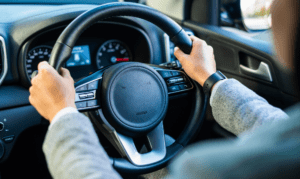
Crossing your hands on the steering wheel is a topic that often confuses learners, leaving them unsure if it’s allowed or if it will result in an instant fail on the driving test. However, we’re here to provide some clarity and good news. The truth is, crossing your hands while steering won’t automatically lead to a fail on your driving test. In fact, if done correctly, you won’t even receive a fault for it.
- How is steering marked on the practical test?
- Will I fail if I cross my hands on the driving test?
- What’s the best way to steer?
- Common steering mistakes on the driving test
Understanding how steering is assessed during the practical test is key to understanding why crossing your hands can be acceptable. Examiners are primarily looking for safe and effective control of the vehicle. As long as you maintain full control of the vehicle and execute manoeuvres smoothly and safely, crossing your hands won’t be a problem.
However, it’s important to note that crossing your hands should be done correctly to ensure safe and efficient steering. Instead of crossing your hands over the central point of the wheel, which can be inefficient and potentially hazardous, it’s recommended to use the push-pull technique.
This involves placing your hands at the quarter-to-three or ten-to-two positions on the wheel and using a pushing and pulling motion to steer. This method allows for better control and reduces the risk of your hands getting tangled or causing jerky movements.

Ultimately, the key is to demonstrate safe and competent driving skills during your test. If you can confidently control the vehicle and perform manoeuvres smoothly, including crossing your hands using the push-pull technique, you can rest assured that it won’t result in a fail or even a fault. Just remember to prioritise safety and follow the rules of the road throughout your driving test.
How is steering marked on the practical test?
The steering component of the practical driving test falls under the ‘Control‘ section, which assesses your ability to safely and smoothly use the primary controls of the car, including the steering wheel, foot controls, and handbrake. The main objective is to remain in full control of the vehicle throughout the test. Failure to do so can result in faults, and in some cases, lead to test failure.
There are different types of faults that can be incurred during the driving test. Driving faults, also known as minor errors, are not severe on their own, but repeated occurrences can escalate their seriousness. You are allowed up to 15 driving faults before it results in test failure.
Serious faults, previously referred to as major faults, involve actions or inactions that have the potential to be dangerous. Committing a serious fault during the test results in an immediate failure.
Dangerous faults encompass actions that pose an actual danger to others or objects, such as buildings. Making a dangerous mistake automatically leads to test failure, and the examination may be terminated early.
When it comes to steering, the guidance provided may appear vague. While driving instructors in the UK tend to teach specific techniques over others, you have the freedom to steer in a manner that feels most comfortable to you. The key is to prioritise safety and smoothness, ensuring you meet the overall objectives.
In light of this, it’s important to dispel the myth surrounding crossing your arms while steering. Contrary to what you may have heard, crossing your arms or adopting unconventional hand positions is perfectly acceptable during the driving test. So rest assured, this myth has been debunked!
Will I fail if I cross my hands on the driving test?
Rest assured, crossing your hands on the driving test alone will not result in an automatic failure. However, it’s important to consider the execution and situation surrounding this technique. Just because you can cross your hands doesn’t always mean it’s the best approach. Your level of control is the key factor to consider.
It’s worth noting that the notion of crossing hands being problematic may have stemmed from the fact that it can be riskier in certain situations compared to other steering methods.
There are two scenarios to distinguish between, as they can have different implications during the practical test. Understanding these distinctions is crucial, as one scenario may potentially result in a fault, while the other is less likely to do so.
Keeping your hands in a fixed position as you turn
It’s important to distinguish between small adjustments of the steering wheel to navigate slight bends in the road, which is perfectly acceptable to keep your hands in position.
However, when it comes to taking sharp corners or turning at junctions without releasing your hands from the wheel, the situation is different. As your arms reach a crossed and tangled position, it becomes quite awkward and compromises your level of control. This technique is likely to result in a fault during your driving test. Let’s explore the reasons behind this.

- Firstly, your arms have limitations. Eventually, you will need to make significant adjustments to your hand position to complete the turn properly.
- Secondly, attempting to correct your hand position from such an extreme crossed position often leads to jerky steering, which examiners take note of as a red flag.
- Lastly, crossing your hands in this manner positions your wrists directly over the airbag. In the unfortunate event of an accident where the airbag deploys, the forceful impact can cause your wrists to collide with your face, potentially resulting in injuries. Additionally, any jewellery worn on your wrists could splinter and cause harm.
Considering the potential dangers and compromised control, it’s best to avoid crossing your hands in this manner. Failing to navigate the road layout effectively due to this technique poses a significant safety risk, leading to a failed driving test.
Hand-over-hand steering
Hand-over-hand steering is a technique where you pull on the steering wheel with one hand and then cross the other hand over to continue the turn. Here’s how it works:
- Turn the wheel until one hand reaches past 12 o’clock.
- Lift the other hand off the wheel.
- Reach across your other hand to grasp the opposite side of the wheel.
- Pull the wheel round.
- Repeat the process as needed.
Compared to simply keeping your hands on the wheel, hand-over-hand steering is generally considered a safer method. By proactively crossing your hands, rather than your entire arms, your hands will be crossed for a shorter duration and in a more comfortable position.
However, hand-over-hand steering is not commonly taught in the UK for a few reasons:
- It can lead to quick and potentially excessive steering inputs. While this may sound appealing, especially in certain situations, it can result in oversteering and a loss of control, which can lead to a deduction on your practical test.
- It positions your wrists in a vulnerable spot. As mentioned earlier, if the airbag deploys, your wrists are at risk of injury due to their position.
On the other hand, if you find hand-over-hand steering to be natural and you can execute it effectively, there’s no need to change your technique. Your driving examiner will not penalise you for using this method.
So, like many things, whether crossing your hands will lead to a failed practical test depends on how you execute it and its impact on your driving performance.
What’s the best way to steer?

The pull-push technique
The predominant steering technique taught in UK driving lessons is the pull-push technique, although it is not a requirement for passing your practical test. This method involves pulling down with one hand and then pushing up with the other as you turn, without crossing your hands on the wheel.
Here’s how the pull-push technique works:
- Slide both hands up to the 12 o’clock position on the wheel.
- Pull down with one hand, which corresponds to the direction you want to turn while sliding the other hand down the opposite side.
- Your hands should meet at the 6 o’clock position on the wheel.
- Pull upwards with your opposite hand until it reaches the 12 o’clock position while sliding the other hand up the other side.
- Your hands should meet again at the 12 o’clock position.
- Repeat this process as needed or reverse the steps to straighten the wheel.
Some driving instructors question why the pull-push method is still taught when hand-over-hand steering is considered less risky. The answer lies in the fact that the pull-push technique helps develop strong hand coordination and offers excellent control.
Once you become proficient in this technique, it will become second nature, allowing you to steer smoothly and accurately through bends and junctions without much conscious effort.
Top Tip: To practice your pull-push steering, you can use a frisbee or a large book outside the car. Additionally, if you have the opportunity and are willing to set aside any self-consciousness, try “air steering” like playing air guitar as a passenger whenever the driver turns at a junction. This exercise will assist you in getting a better grasp of the desired steering action.
Positioning your hands
There is a common misconception that driving examiners will penalise you for placing your hands in the “wrong” position on the steering wheel.
In reality, you are allowed to hold the wheel in any way that allows you to maintain control of the car, while still being able to access secondary controls like indicators.
During your driving lessons, you may be taught to position your hands at “10 and 2” or “9 and 3” on the wheel, corresponding to the numbers on a clock. Both of these positions offer good control and prepare you for the pull-push technique when approaching junctions or sharp corners.
Traditionally, the preferred grip was at 10 and 2, but many people find 9 and 3 more comfortable. This hand position brings your arms closer to your body, allowing for a more relaxed and stable posture.
Ultimately, the hand placement that feels most natural to you will likely serve you best. Just remember to consider your hand position when adjusting the steering wheel to ensure optimal comfort and control.
Common steering mistakes on the driving test

Oversteering
One common steering mistake to avoid is oversteering, which occurs when you steer too sharply for the road layout. This can be dangerous as it may cause you to hit the curb or put yourself in the path of oncoming traffic.
To prevent oversteering, it is important to keep your eyes focused on the furthest point you can see in the middle of your lane, without straying into another lane. As you make your turn, this point will shift, so continue aiming for the new point to maintain your direction accurately.
Additionally, remember that power steering assists you in steering, so your role is to guide the wheel with small and precise movements.
Poor timing: turning too early or too late
Another mistake to avoid is poor timing, such as turning too early or too late. Cutting corners or driving too far before starting to turn can result in steering errors and the need for overcorrection, both of which can lead to faults on your test. If you struggle with determining the right time to steer left or right.
Remember, crossing your hands on the practical test does not automatically result in a fault or failure, although there may be consequences in certain situations.


